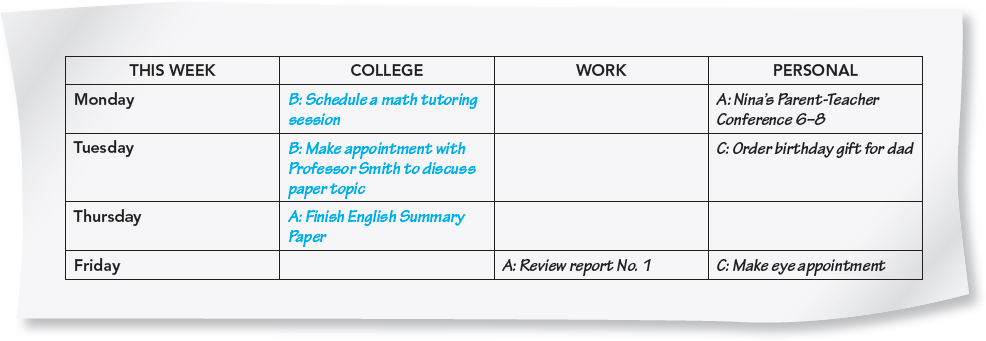Setting Priorities
To stop procrastinating, think about how to prioritize, which means putting your tasks, goals, and values in order of importance (In the section Managing Your Energy later in this chapter, we’ll discuss strategies to avoid becoming overextended. This goes hand in hand with setting priorities). Ask yourself which goals are most important but also which ones are most urgent. For example, studying in order to get a good grade on tomorrow’s test might have to take priority over attending a job fair today, or completing an assignment that is due tomorrow might have to take priority over driving your friend somewhere.
However, don’t ignore long-term goals in order to meet short-term goals. With good time management, you can study during the week prior to the test so that you can attend the job fair the day before. Skilled time managers often establish priorities by maintaining a to-do list on which they rank the items to determine schedules and deadlines for each task.
Once you have entered your future commitments in a term planner and decided how your time will be spent each week, create your to-do list, which is especially handy for last-minute reminders. A to-do list helps you keep track of errands to run, appointments to make, and anything else you might forget. You can keep this list on your cell phone or tablet, in a notebook, or on your bulletin board. Use your to-do list to keep track of all the tasks you need to remember, not just academics. Consider developing a system for prioritizing the items on your list: using different colors of ink for different groups of tasks; highlighting the most important assignments; marking items with one, two, or three stars; or adding letters A, B, C, and so on to indicate what is most important (Figure 2.4). As you complete each task, cross it off your list. You might be surprised by how much you have accomplished and how good you feel about it.

Finding a Balance.Another aspect of setting priorities while in college is finding a way to balance your academic schedule with the rest of your life. Social and extracurricular activities (e.g., participating in a club, writing for the college newspaper, attending lectures) are important parts of the college experience. Time spent alone and time spent thinking are also essential to your overall well-being.
For many students, the greatest challenge of prioritizing will be balancing college with work and family obligations that are equally important and are not optional. Advance planning will help you meet these challenges. You should also talk with your family members and your employer to make sure that they understand your academic responsibilities. For example, you may be able to take a day off from work to prepare yourself for the final exam of a challenging course. Most instructors will work with you when conflicts arise, but if you have problems that can’t be resolved easily, be sure to seek support from your college’s counseling center. The counselors will understand your challenges and help you prioritize your many responsibilities.
YOUR TURN > DISCUSS IT

Review the calendar for this month that you mapped out in the Your Turn: On Your Own activity and use letters, numbers, or other symbols to prioritize your tasks (A through F, 1 to 5, or 1 star to 5 stars). What are your most important obligations, other than your studies, that will have to fit into your time-management plan? Are any of them more important to you than doing well in college? Why or why not?

Staying Focused.Many students of all ages question their decision to attend college and sometimes feel overwhelmed by the additional responsibilities it brings. Some first-year students, especially recent high school graduates, might temporarily forget their main purposes for coming to college and spend their first term of college engaging in a wide array of new experiences.
Allowing yourself a little time to adjust to college is OK within limits, but you don’t want to spend the next four or five years trying to make up for poor decisions made early in your college career, such as skipping class and not taking your assignments seriously. Such decisions can lead to a low GPA and the threat of academic probation, or worse, academic dismissal. Keep in mind that your grades will forever remain on your college transcript. You must send your transcript with your transfer application to a four-year college or university, and some employers might ask for a copy when you apply for a job.
A great way to focus (and to keep your priorities on track) is to finish what needs to be done before you move from work to pleasure. From time to time, you might have competing responsibilities; for example, you might have to work additional hours when you have an exam. In cases like these, talk to the people involved, including your instructors, to see how you can manage the conflict.